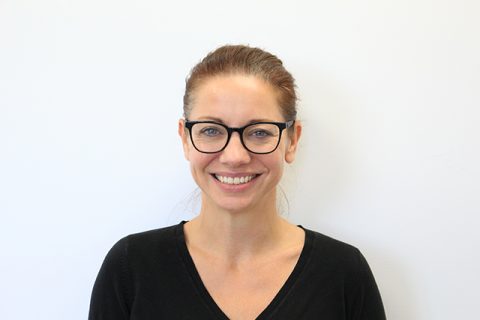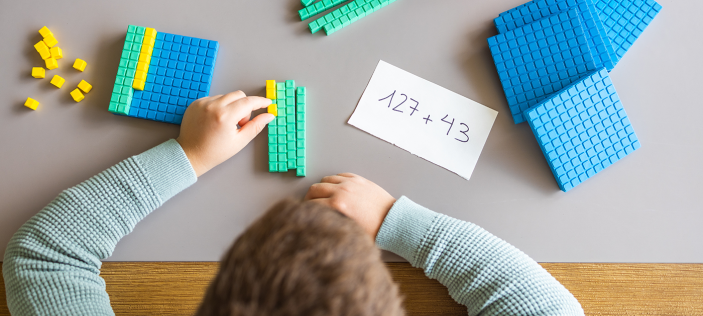“Yeah, they're great to use in maths, but you want every child to be curious, don't you? Across every single subject, because that's how you learn."Ashleigh Calver, Assistant Headteacher, Maths subject lead and Year 6 teacher, Longlands Primary School, Hertfordshire
"We want our children to be curious in all subjects; we want them to make connections across the curriculum".Suzanna Neate, Assistant Headteacher, Maths subject lead and Year 6 teacher, St Margaret of Scotland Primary, Bedfordshire
So what exactly are these leaders talking about? They are discussing with us the Greater Depth Maths materials which were developed to respond to the requests that we, as a team of maths advisers, we're always hearing. “Got any ideas for my greater depth?” You can read our earlier blog about this where we consider, in detail, what Greater Depth in maths could actually mean and the importance of having this discussion within your schools.
What we ended up developing moved wildly beyond our original thoughts; it became about the development of the whole child - skills and behaviours that could be used across the whole curriculum but nurtured in a maths classroom - and about the inclusion of ALL children.
This blog aims to share some of the incredible outcomes for children and teachers who have already engaged with the resource.
How schools have started
Longlands Primary School (Broxbourne, Herts) and St Margaret of Scotland Catholic Primary School (Luton, Beds) trialled the materials in their schools to see the impact on children and teachers. Each school chose a different deployment pathway; however, they both started with a launch staff meeting led by one of the authors of the books and HfL Primary maths advisers.
During the launch staff meeting, teachers had a chance to explore both the books and the online resources and got stuck in to the 6C cycle detailed in this training slide:
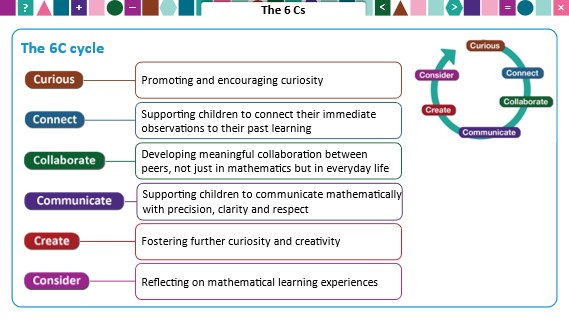
The training
Suzanna, Year 6 teacher, St Margaret of Scotland
As Suzanna expresses, one of the strengths of the resource is its flexibility: "You can do it however you like." It can be led by your current school development priorities. You can choose to focus just on a couple of the Cs or complete the whole cycle.
Following the staff meetings, leaders supported their staff to choose how they wanted to use the resources. For Longlands, this meant choosing a task and then exploring the curious prompts, encouraging children to ask mathematical questions which they could then explore through the connect section (where they solve the problem).
St Margaret of Scotland decided to take a task and go through the full 6C cycle, spending between 3 and 5 lessons exploring the task fully.
Getting started
Siobhan, Year 5 teacher, St Margaret of Scotland
Teachers were surprised
Suzanna, Maths subject lead, St Margaret of Scotland
Focused development of behaviour
Longlands decided to focus on developing children’s curiosity. One of the impacts we have seen of essential remote teaching is that children have returned to our classrooms more passively.
Curiosity, to me, is the internal desire to acquire new information. Our bodies reward us when we have satisfied curiosity with a shot of dopamine, so we feel good. Curiosity has been shown to benefit both learning and memory (Gruber, Valji and Ranganath, 2019). If we can make children curious, they will be self-motivated and take control of their own learning.
However, allowing children to develop their own lines of enquiry and feel that they are pursuing their own investigations can make some primary teachers anxious. The Greater Depth Maths resources enable teachers to stay in control by using the 'covert' strategies provided, meaning the children believe they have self-generated their own questions. Yet, they have in fact been operating within tight parameters.
Progression through the complete cycle
As mentioned, St Margaret of Scotland decided to undertake a complete cycle; they wanted to assess the children's current abilities across all the 6Cs. To do this, they made use of both the Stumble Support and the assessment rubric which are key elements included within the resources.
Suzanna, Maths subject lead, St Margaret of Scotland
Enabling access for all – Stumble Support and assessment rubrics
All the resources required to enable teachers to accurately identify ALL children's strengths and development requirements are provided across all the behaviours and skills. For example, Suzanna discusses how the teachers identified that some of their higher attaining children in maths needed to enhance their communication and collaboration skills and so this became a focus.
Stumble Support is provided throughout the resource to help teachers see how to get children moving forward again in their learning if they become stuck. This comes in many different forms; teacher questions, additional PowerPoint slides, alternative concrete models, speaking frames, word banks etc. In this video clip, Suzanna speaks about how the unique Stumble Support and the assessment rubrics work in tandem.
Impact on teachers
One of the outcomes we repeatedly encountered on our trips back into the project schools was the sheer joy and enthusiasm that radiated from the teachers. They enjoyed teaching the tasks. They expressed that they felt freedom in their teaching.
“I really enjoyed using it.”Ashleigh, Year 6 teacher, Longlands
“I enjoyed letting the children lead it.”Steph, Year 1 teacher, Longlands
Gavin, the Year 4 teacher, spoke with such enthusiasm to us about the task that he had explored with his children. He told us how both he and the children thoroughly enjoyed the task and how when he told the children that they were moving on to a new concept, this was meet with an ‘Oh!’ from his year 4s as they were so keen to continue. Gavin has decided that he will revisit the task at a later point to allow the children to move through some more of the 6Cs.
Developing skills beyond knowledge
Pauline, Year 6 teacher, Longlands
Skills beyond knowledge
Both schools have kindly given us permission to share some of the children’s work created during their exploration of the tasks.
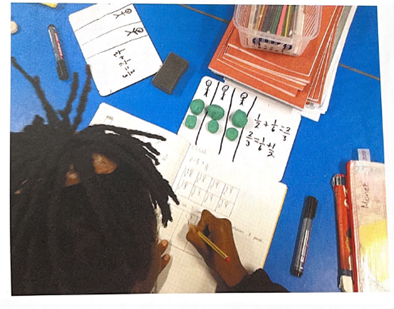
Here, Year 5 pupils were tackling a problem involving fractions at the Connect stage. This child chose to use playdoh alongside their own pictorial representations.
Ashleigh, the maths subject leader, commented that using the manipulatives supported children with their use of language and in drawing connections to their knowledge of equivalence.
She also noted that one child, who often lacks confidence to join in class discussion, was able to demonstrate what a resilient learner she was; she and her partner developed their own way of recording and tackling the problem.
Teachers also made sure to capture what the children were saying using the sentence stems on the curious prompts. The prompts helped the children to articulate their initial thoughts in full sentences before exploring the prompt further and heading into the ‘Develop and Deepen’ element.
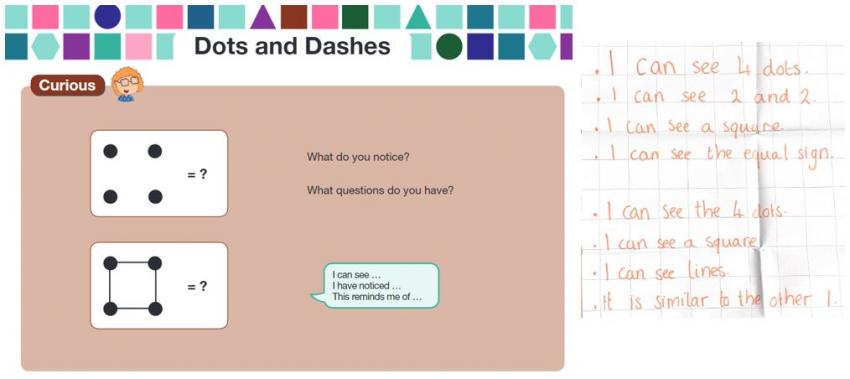
Steph, the Year 1 teacher at Longlands, described to us how she revisited the prompt in short 10-minute sessions across a week where the children begun by investigating the task and then by the final session, were exploring their own representations.
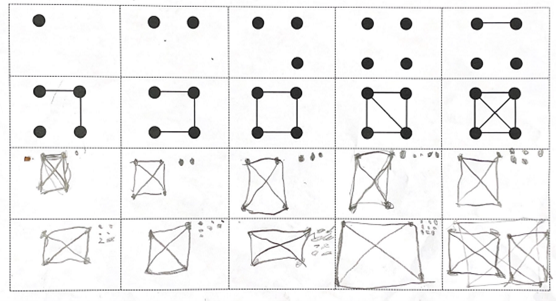
The children were excited to revisit the task and like Gavin, Steph plans to come back to the task in the summer term to explore more of the cycle.
Teachers at St Margaret of Scotland use ‘floor books’ across the curriculum to capture collaborative work from their classrooms and decided that this was how they wanted to record children’s responses to the tasks. Each floor book was created along with the children, who take ownership and much pride in them, as we are sure that you will see from these snapshots.
Task: Crossing the River
Key Stage 1
Task: Triple Trick
Lower Key Stage 2
It has been an absolute privilege for us to work with both Longlands and St Margaret of Scotland: to set them off on their journey with the greater depth materials and to later visit them to see the excitement generated and impact of their work so far. We can’t wait to see where they take it next!
You can also download some free samples.

The Herts for Learning primary maths team are also able to offer bespoke in-school training.
Please contact us for further information and details of pricing on 01438 544464 or email info@hertsforlearning.co.uk.
References
Gruber, M.J., Valji, A. and Ranganath, C., 2019. Curiosity and learning: a neuroscientific perspective.
Blog authored by Charlie Harber and Laura Dell.
